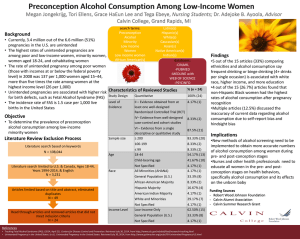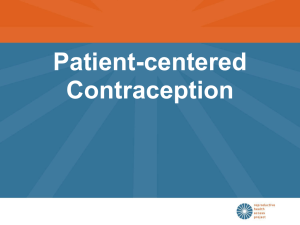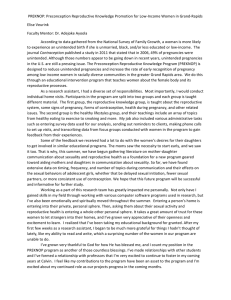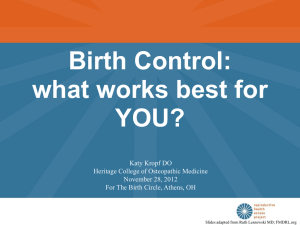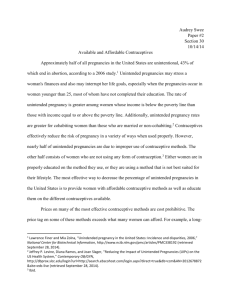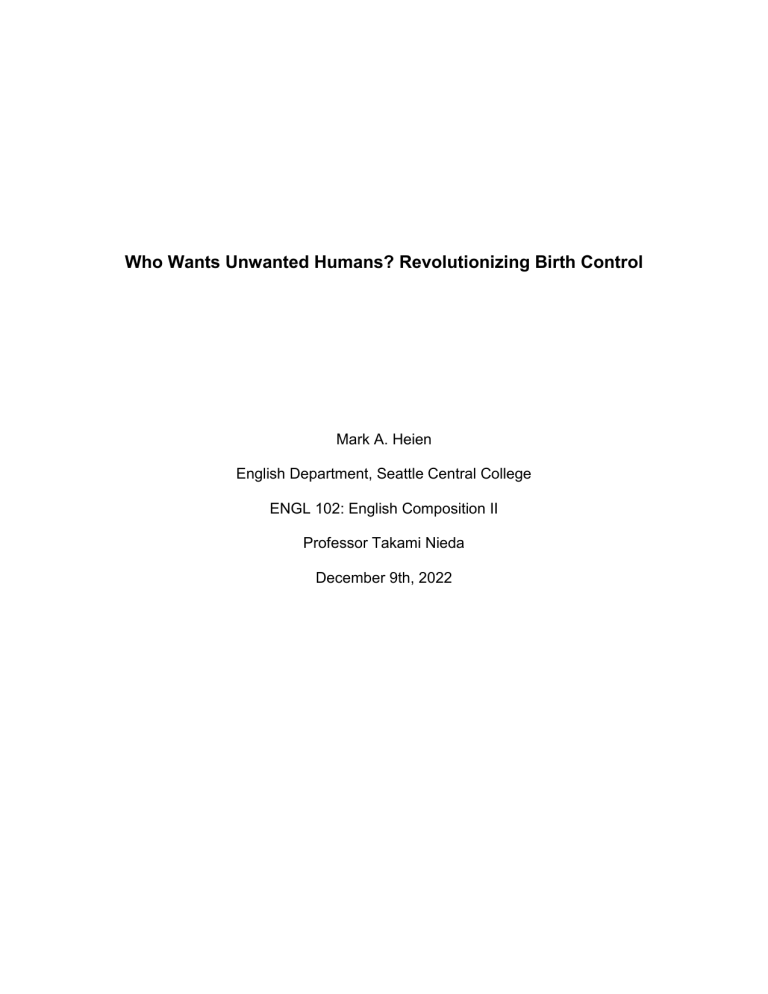
Who Wants Unwanted Humans? Revolutionizing Birth Control Mark A. Heien English Department, Seattle Central College ENGL 102: English Composition II Professor Takami Nieda December 9th, 2022 ABSTRACT Imagine a scenario where 2 people addicted to drugs have sexual intercourse. An egg is fertilized by the spermatozoa and for whatever reason, it’s taken to full term and a child is born. What is the likelihood that human will have a good life? Who’s responsible to raise that human into a fully functional adult? Is this a rare occurrence? Over 20,000 babies are born each year dependent on illegal or prescription drugs and suffer neonatal abstinence syndrome (NAS), a type of opiate withdrawal. That’s the equivalent of one baby every 25 minutes. Not only do we have mistimed babies born addicted to drugs, but the United States also has an much broader epidemic of unintended, unwanted, and mistimed pregnancies. According to Monea & Thomas, the annual unintended pregnancies cost is estimated to be between $9.6 billion and $12.6 billion respectively. The savings that taxpayers would see by preventing unintended pregnancies is estimated to be between $4.7 billion and $6.2 billion. The taxpayer cost for each unintended, publicly subsidized pregnancy is approximately $9,000; preventing such a pregnancy would help taxpayers save about half of that amount. Monea, E., & Thomas, A. (2011). Although the current methods of prevention (abortion, condoms, "the Pill", family planning, and other forms of education) have been around for many years, the problem is still endemic in society. The United States has a serious and complex problem with unintended pregnancies. This has significant consequences for all Americans. I am interested in exploring possible solutions that are not part of the public debate and discourse. Unwanted pregnancies have been distorted by personal, religious, and political ideologies. We now focus all our attention on pro-life vs. pro-choice. As a result, the health and well-being of unintended children has received far too little attention. I want to see beyond ideology and find solutions that go beyond what is currently possible. As I have uncovered in my research, there have been no significant improvements to stopping unwanted pregnancies since 1950 when the pill was invented for female birth control. Usage of birth control is estimated to be around 65% in sexually active females. The last advancement to male birth control was the condom which was introduced in 1858. The estimated use of condoms is estimated to be between 35-75% depending on the age of the male. Consequently 100% contraceptive use is unattainable, based on this research, there are some gaps that can be filled to help prevent unwanted pregnancy. Unwanted, unintended, and mistimed pregnancy is a general term that represents a pregnancy that occurred when a woman wanted to become pregnant in the future, but not at the time she became pregnant (“wanted later”) or one that occurred when she did not want to become pregnant then or at any time in the future (“unwanted”). It includes pregnancies that a woman states were either mistimed or unwanted at the time of conception. Significance Unintended pregnancies account for nearly half of all pregnancies within the United States. Unintended pregnancies are more common among young women and adolescents, as well as women of ethnic or racial minorities and women with lower education and income. These pregnancies are likely to be a significant cost for taxpayers. However, there have not been any national estimates of the public costs. 2006 saw 64% of unintended pregnancies being funded by the public. This compares with 48% and 35% respectively for all births. There was a wide range of states that varied in the proportion of unintended pregnancies funded by public funds, ranging from 42% to 81%. Out of the 2.0 million births that were publicly funded, 51% were the result of unintended pregnancies. This accounts for half the public birth costs. Seven states had births that were unintended, with costs exceeding a half-billion dollars. (Sonfield, Kost, Gold, & Finer (2011) Unintended pregnancies can be prevented, which is a huge opportunity for the public to make substantial economic savings. Unintended pregnancy has many negative outcomes beyond economics. These include the emotional impact on the unborn child, reduced educational opportunities, labor-market struggles, and higher crime rates. A Brookings Institute study found that approximately 40% of unplanned pregnancies result in an abortion and 60% lead to a birth. This means that only one-third of all unplanned births occur. The public is still divided on abortion, with nearly equal numbers of people identifying as pro-life and pro-choice. However, most everyone supports contraception. Contraception is still only available to women, except for condoms. Is there a need for funding reversible male birth controls? This brings me to my central point. The current methods of preventing unwanted pregnancy have a mixed rate of efficacy. There are solutions we can address to fix the problems within the system. There are also advances within the medical and science arena that need to be funded and studied to put a stop to this crisis! The Role of Poverty and Education There is a disproportionate number of unwanted pregnancies in poor and low educated communities. Many of these unwanted children are born premature and have low birth weights. These children are at a higher risk for death due to health complications during infancy than children born at term from planned, wanted families. They also are at higher risk of suffering from developmental disabilities throughout their lives due to the difficulties they experience in the womb. An unplanned child born in the U.S. has roughly a one in three chance of being in foster care before their first birthday; a child born into poverty has a one in two chance of being in foster care by their first birthday; a child born into a low income family has a one in two chance of being incarcerated during their lifetime; an unplanned child born to a teenage mother has roughly a one in three chance of dropping out of high school; and an unplanned child born to a teenage mother has roughly a one in five chance of becoming pregnant again before they turn eighteen years old. The consequences are far reaching and hard to measure but the impact on society is significant. For each year a child stays out of the foster care system it can save taxpayers an estimated $210,000 per year in social-service costs; each year an adolescent avoids incarceration it can save taxpayers an estimated $350,000 per year; each year a high school dropout avoids becoming a teen parent it can save taxpayers an estimated $250,000 per year. The personal, physical, emotional, and financial burdens to families are often incommensurable. Women and children often bear the extensive burden of these unplanned, unwanted births. Disparity in rates of low infant birth weight is on the rise, with overall rates four times higher than they are in higher income and well-educated. Several studies have been conducted that examine unintended pregnancy as a correlate to poverty. These findings show that low-income women are significantly more likely to become pregnant unintentionally than women at or above poverty level. It is currently estimated that more than one-third of all American women will have an unintended pregnancy at some point in their lives. Women living in poverty have a rate of six to seven percent compared to one percent for women at or above poverty level. Low-income women also experience higher rates of repeat pregnancy and are more likely to have abortions than higher income women. This is problematic because all women deserve the right to decide if and when to have children for themselves without coercion, pressure, intimidation, manipulation, shame, guilt or stigmatization. Additionally, we should not be forcing women in poverty and low income into having another child because they cannot control their fertility. Contraception should be available for all women and should be affordable to all women who need it regardless of their income status. It’s obvious to conclude that making contraception more available and affordable would reduce the rate of unintended pregnancy and the number of unwanted children who would be born in the United States. Increasing access to affordable and effective contraception would have a direct impact on reducing the societal costs of poverty and increasing opportunities for upward mobility for all Americans. Specifically, if all low-income women were using effective contraception, it would decrease the U.S. poverty rate by approximately five percent; if the federal family planning budget were cut by half it would increase the poverty rate by almost two percent. Obviously, as the percentage of contraceptive use increases, the number of unintended pregnancies will decrease, creating an estimated savings of over 6 billion dollars per year. What Programs are currently available? Currently, most public funds for contraceptive services flow through Medicaid and the Title X Family Planning Program, in Fiscal Year 2016, $286 million was spent by the federal government on family planning services and supplies through Title X. Additionally, Maternal and Child Health Services Block Grant, the Social Services Block Grant, community health centers, and migrant and rural health centers also help to provide reproductive health services in various ways. In Fiscal Year 2016, $311 million was spent on non-federal sources of funding for family planning. Of this amount, $94 million was spent on private sources and $215 million was spent on state and local initiatives and programs (Guttmacher Institute, 2019). The impact of Title X and Medicaid, the two largest public programs, on unintended pregnancy has not been clearly defined, although several studies have tried to assess the effect of "publicly supported family planning programs" (which typically include the Title X and Medicaid programs) on various fertility measures, usually pregnancy and birth rates. While abortion is a controversial topic with divided opinions, we must also recognize that when a woman chooses to have an abortion, she is deciding based on her own beliefs. She should not be forced to carry an unwanted pregnancy to term simply because she does not have the financial resources to provide for herself and the baby. Current state laws regarding abortion vary from state to state, which makes it difficult to compare statistics between states. However, several studies have been conducted that examine the correlation between abortion rates and income. One such study was performed by the Guttmacher Institute (2014) which examined data from all fifty states and the District of Columbia for the period of 1990-2010. This study examined the correlation between state abortion rates and both median family income and the percentage of households below the poverty level. This study concluded that "states with higher levels of income and poverty have lower levels of induced abortion." Additionally, the study showed a direct correlation between median income and the rate of induced abortions among adolescents aged fifteen to nineteen years old; teenagers from wealthier families were significantly less likely to have had an abortion than those from poorer families. The study also found that "States with both high proportions of low-income families and high proportions of abortions have higher percentages of teen births than do states with lower levels of both measures." Overall, these studies show that states that have a lower percentage of low-income families also have lower rates of abortions; therefore, it is logical to conclude that there is a correlation between household income and the rate of unintended pregnancies in the United States. Therefore, if more families can improve their economic standing there will be fewer unplanned pregnancies and fewer unplanned births. Clearly, providing financial support to purchase needed contraceptives would decrease the number of unplanned pregnancies resulting in fewer unwanted children being born in the United States. Additionally, making contraceptives more affordable and accessible for both men and women will have a significant positive impact on reducing unintended pregnancy and reducing the number of children living in poverty. The United States is the wealthiest country in the world with one of the highest rates of poverty in the developed world. There are approximately one hundred million Americans living in poverty; 46 million of these Americans are living in extreme poverty. The statistics related to poverty in this country are staggering, yet most Americans are oblivious to the fact that there are more than forty million Americans living in poverty; in fact, most Americans assume that only poor people live in impoverished communities. Poverty does not discriminate; it impacts all Americans regardless of race, gender, age, or sexual orientation. Approximately fifty percent of all African American children are born to single mothers living below the poverty line; this is three times higher than the rate for children from other racial groups. Children who grow up in poor families are four times more likely to live in poverty as adults; they are also less likely to graduate from high school or college. Once born into poverty, the odds of making it out without falling victim to it is very low; most children who grow up in low-income households remain there as adults. These statistics prove that children born into low-income households are at a disadvantage from birth. Currently, most public funds for contraceptive services flow through Medicaid and the Title X Family Planning Program, in Fiscal Year 2016, $286 million was spent by the federal government on family planning services and supplies through Title X. Additionally, Maternal and Child Health Services Block Grant, the Social Services Block Grant, community health centers, and migrant and rural health centers also help to provide reproductive health services in various ways. In Fiscal Year 2016, $311 million was spent on non-federal sources of funding for family planning. Of this amount, $94 million was spent on private sources and $215 million was spent on state and local initiatives and programs. The impact of Title X and Medicaid, the two largest public programs, on unintended pregnancy has not been clearly defined, although several studies have tried to assess the effect of "publicly supported family planning programs" (which typically include the Title X and Medicaid programs) on various fertility measures, usually pregnancy and birth rates. The effect of public fund expenditure on unintended pregnancy is unclear and needs direct study to determine efficacy. Currently, there is no national program whose primary mission is to reduce unintended pregnancy. National programs to help reduce the number of unwanted pregnancies in the U.S. need to be developed and implemented to provide the necessary resources to ensure every child born in America is wanted. These programs should include education initiatives to teach young adults how to recognize and avoid dangerous situations that could lead to an unwanted pregnancy as well as improve awareness of and access to birth control. In addition to educational initiatives, financial support should be provided to those women who are unable to obtain contraceptives on their own through work-based health plans or private insurances. There is a need to precisely track unintended births and what programs are most effective at stopping them. This type of targeted data would provide better understanding of what programs need development. It would also sharpen the delivery of current programs aimed at preventing unwanted births. Who is Utilizing What’s Currently Available? What is the current utilization of contraceptive methods that are publicly available? In 2015–2017, approximately 65% of women aged 15–49 were currently using contraception. Of the women currently using contraception, around 45% were using an injectable method. In 2015–2017, 64.9%—or 46.9 million of the 72.2 million women aged 15–49 in the United States—were currently using a method of contraception. Current contraceptive use increased with age, from 37.2% among women aged 15–19 to 73.7% among women aged 40–49. The most used contraceptive methods in women were IUDs, implants, oral pills, female sterilization, male condoms, withdrawal, and other nonpermanent methods. Of the total women who used contraceptives in the most recent year studied, slightly more than half—56%—used a hormonal method, including oral pills, patches, injections, implants, and IUDs. Female sterilization accounted for an additional one-quarter of all current contraceptive users, while male condoms were used by nearly one-fifth of women. The remaining current users reported using other methods: withdrawal, diaphragms, cervical caps/diaphragms, and emergency contraception. For women who reported ever using a hormonal method of contraception in the past—that is, either an oral pill or a patch—the percentage who currently used a hormonal method declined to around two-thirds. The percentage of non-Hispanic white women currently using contraception (67.0%) was higher compared with non-Hispanic black women (59.9%), but not different from the percentage for Hispanic women (64.0%). Current contraceptive use did not differ significantly across education (68%–76%). Among unmarried men who had sexual intercourse in the last 3 months, use of any male method at “last intercourse” decreased with increasing age. Use of any male method was highest among never-married men (75.1%), followed by formerly married (55.3%) and cohabiting (35.9%) men. Use of any male method was higher for non-Hispanic black men (65.0%) compared with Hispanic men (54.8%). As shown, current contraceptive use varies among different groups. This data can be useful to target lower trending groups through education and marketing initiatives, as well as allocation of resources for targeted ease of distribution and availability. What is in development? I have also discovered that there are some potential reversible birth control options being studied for men. The invention of the birth control pill was a significant milestone in the women’s rights movement. Since then, other long-acting, reversible contraceptives (LARCs) have been developed for women, and women now have a total of 11 methods to choose from, including barrier methods, hormonal methods, and LARCs. In contrast, men only have 2 options—male condom and vasectomy—and neither are hormonal methods or LARCs. The disparity between the number and types of female and male LARCs is problematic for at least two reasons: first, it forces women to assume most of the financial, health-related, and other burdens of contraception, and second, men’s reproductive autonomy is diminished by ceding major responsibility for contraception to women. A more just contraceptive arrangement can only be achieved through the development of male LARCs and reconceptualizing the responsibility for contraception as shared between men and women. While not being responsible for some or all these burdens is a significant boon for men, at the same time, men’s reproductive autonomy is inhibited by the famine of male contraceptives, especially LARCs. Given the condom’s high failure rate of 16 percent during typical use, men who want to maintain the possibility of having biological children are not able to regulate their reproduction as effectively as women are—most female LARCs have failure rates under 3 percent. The lack of effective and reversible options for men forces many men to rely on their partners for contraception. Men must trust that their partners are correctly and consistently using contraception. Regardless of the circumstances under which pregnancies occur, men are still held socially and financially responsible for any children they father. Today men are more actively involved in childrearing than previous decades; for example, 71 percent of children under 6 eat dinner with their fathers every day, 15 percent of single parents are men, and 154,000 men in the U.S. are stay-at-home dads. This increased involvement shows that pregnancy does indeed have significant impact on men—a good reason for men to want more control over their reproductive autonomy. There is no question that, due to contraceptive advances, the contraception situation women in the U.S. face today are vastly better than 60 years ago. That said, however, the current contraceptive situation is still unjust. Women bear most of the contraception responsibility and the burdens it entails, while men have limited reproductive autonomy. In a way, the current contraception arrangement is more problematic than the previous one because its injustices are often hidden, or at least sidelined, by the dominant rhetoric of women’s empowerment and equality. This dominant rhetoric sends the message that women should be content and grateful for the current situation, thus marginalizing and even silencing any complaints or suggestions for improvements. As a matter of social justice, we should move toward shared contraception responsibility. To do this, more resources are needed to fully develop and bring to market male birth control and LARCs. Researchers are looking into developing a reversible male birth control method that causes sperm to become sterile. Currently there are 5 variations that are in different stages of development and clinical trials. 1. A single injection that ensures a man cannot cause a pregnancy for years and is completely reversible. RISUG (reversible inhibition of sperm under guidance) is a nonhormonal, minimally invasive shot effective for up to 10 years. It has shown promising results in other countries, and in the U.S. it’s the male contraceptive option furthest along in clinical trials under the name Vasalgel. The injection is also reversible and appears to have no side effects. 2. A reversible male birth control that impacts the head of the sperm, preventing it from fertilizing an egg. 3. A biodegradable implant injected just below the skin’s surface that can deliver a male contraceptive over a sustained period. 4. A daily, or even on-demand, method of male birth control that prevent sperm from being able to swim when taken. 5. A reversible male birth control method that causes sperm to become sterile. It’s clear that putting a reversible long-acting birth control modality into the hands of the other 50% of the population that are responsible for unwanted births would be a game changer. It’s vital that public funds, health insurance, medical providers, and pharmacies are aligned and prepared once there is an FDA approved product. Conclusion The current methods of preventing unwanted pregnancy have a mixed rate of efficacy. Its clear systems can be further refined to effectively deliver education and contraceptive resources to those who need them most. Every human should be wanted and ought to receive the nurture, support, education, and resources to develop into responsible, self-sufficient, and productive adults. Through the 1950s, men took responsibility for contraceptives, usually condoms. But the debut of the female pill in 1960 changed everything. Since that time, the responsibility for contraceptives has shifted onto women, and many critics have complained, not unfairly, about this burden. It’s time we press our government for further funding and development of medical advances to level the responsibilities of unwanted pregnancies into the hands of both egg and sperm contributors. Based on the data and studies, I can conclude that the greatest impact on preventing unwanted pregnancy will be in a reversible male birth control that is free to the public and readily available. References Sonfield, A. (2015) Guttmacher Institute Retrieved from https://www.guttmacher.org/news-release/2015/unintended-pregnanciescost-federal-and-state-governments-21-billion-2010 Frohwirth, L., Mueller, J., Anderson, R., Williams, P., Kochhar, S., Castle, K. & Kavanaugh, M. (2022) Understanding Contraceptive Failure: An Analysis of Qualitative Narratives, Women's Reproductive Health, Retrieved from https://doi.org/10.1080/23293691.2022.2090304 Brown, SS. & Eisenberg L, (1995) The Best Intentions: Unintended Pregnancy and the Well Being of Children and Families. Washington (DC): National Academies Press (US); 1995. 8, Programs to Reduce Unintended Pregnancy. Retrieved from https://www.ncbi.nlm.nih.gov/books/NBK232131/ Finer, L. B., Institute, A. A. F. the G., Others, A. J. S. and, Richards, C., Others, D. D. and, Others, E. A. S. and, & Others, J. N. E. (2016). Declines in unintended pregnancy in the United States, 2008–2011: Nejm. New England Journal of Medicine. Retrieved from https://www.nejm.org/doi/full/10.1056/nejmsa1506575 Monea, E., & Thomas, A. (2011). Unintended pregnancy and taxpayer spending. Perspectives On Sexual and Reproductive Health, 43(2), 88–93. Retrieved from https://doi.org/10.1363/4308811 Sonfield, A., Kost, K., Gold, R. B., & Finer, L. B. (2011). The public costs of births resulting from unintended pregnancies. Retrieved from https://onlinelibrary.wiley.com/doi/full/10.1363/4309411 Runyan, A., Welch, R. A., Kramer, K. J., Cortez, S., Roberts, L. J., Asamoah, C., Ottum, S., Sanders, J., Shafi, A., & Recanati, M. A. (2021). Long-acting reversible contraception: placement, continuation, and removal rates at an inner-city academic medical center Clinic. Journal of Clinical Medicine. Retrieved from https://doi.org/10.3390/jcm10091918 Danniels, K., & Abma, J. (2019). Products - data briefs - number 327 – December 2018. Centers for Disease Control and Prevention. Retrieved from https://www.cdc.gov/nchs/products/databriefs/db327.htm#:~:text=In%202015%E2%80% 932017%2C%2064.9%25,and%20male%20condom%20(8.7%25) Centers for Disease Control and Prevention. (2022). Prevent unintended pregnancy. Centers for Disease Control and Prevention. Retrieved from https://www.cdc.gov/sixeighteen/pregnancy/index.htm Sawhill, I., & Venator, J. (2016). Proposal 3: Reducing unintended pregnancies for low-income women. Retrieved from https://www.brookings.edu/wpcontent/uploads/2016/06/reduce_unintended_pregnancy_low_income_sawhill_venator.p df Lori Frohwirth, Jennifer Mueller, Ragnar Anderson, Patrice Williams, Shivani Kochhar, S. Kate Castle & Megan L. Kavanaugh (2022) Understanding Contraceptive Failure: An Analysis of Qualitative Narratives, Women's Reproductive Health, DOI. Retrieved from https://www.tandfonline.com/doi/full/10.1080/23293691.2022.2090304
